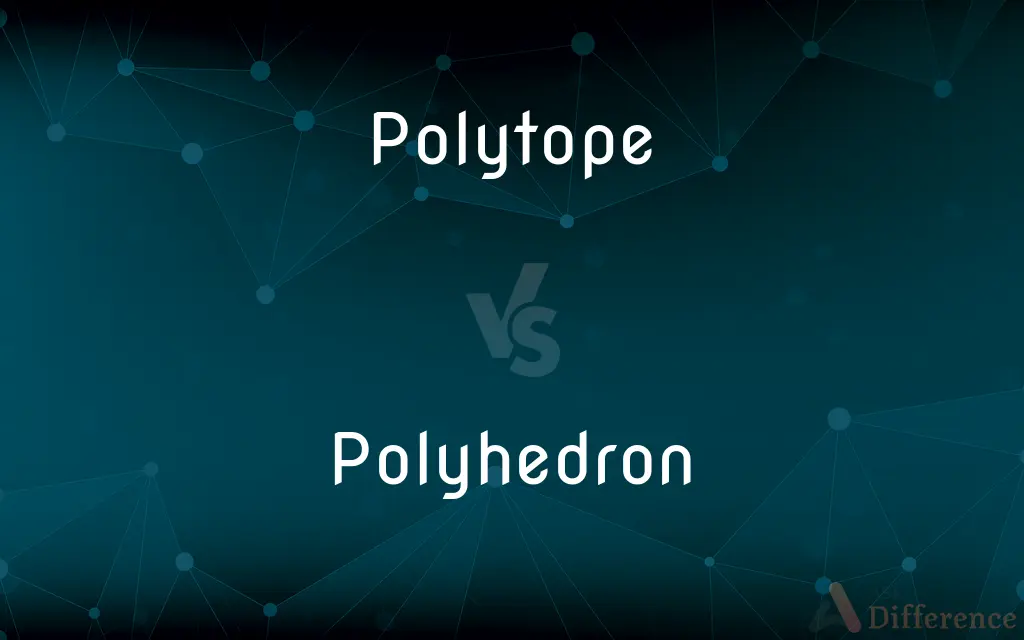Polytope vs. Polyhedron — What's the Difference?
By Urooj Arif & Fiza Rafique — Updated on April 3, 2024
A polytope is a general term in geometry for a geometric object with flat sides, applicable in any dimension, while a polyhedron is a 3-dimensional example of a polytope.

Difference Between Polytope and Polyhedron
Table of Contents
ADVERTISEMENT
Key Differences
Polytope represents a broad category in geometry, encompassing shapes with flat sides in any dimensional space, including lines, squares, cubes, and their higher-dimensional analogs. It's a general term used to describe these geometric objects in mathematics, particularly in the study of multidimensional spaces. On the other hand, a polyhedron is specifically a 3-dimensional polytope, consisting of flat polygonal faces, straight edges, and sharp corners or vertices, such as cubes, pyramids, and prisms.
While polytopes can exist in two, three, four, or even higher dimensions, known respectively as polygons, polyhedra, 4-polytopes, and so on, polyhedrons are confined to the three-dimensional world. This distinction highlights the versatility of polytopes in the study of geometry and topology, whereas polyhedra provide a more tangible, observable instance of these concepts as they can be physically constructed or observed in the real world.
Polytopes are used in various fields of mathematics and science to study the properties of shapes in multidimensional spaces, offering insights into dimensions beyond human perception. Polyhedra, being a subset of polytopes, have applications in both theoretical studies and practical scenarios such as architecture, engineering, and art, showcasing the beauty and complexity of 3-dimensional shapes.
The classification of polytopes is based on their dimensional properties, with terms such as vertex (0-dimensional), edge (1-dimensional), face (2-dimensional), and so on, defining their structure. Polyhedra, therefore, are described by their faces (polygons), edges (line segments), and vertices (points) — a specific case of the more general concept applied to polytopes.
Understanding the concept of polytopes and polyhedra is crucial in the study of geometry, topology, and related fields. Polytopes offer a theoretical framework for exploring multidimensional spaces, while polyhedra serve as a bridge between abstract mathematical theories and the physical world, providing a practical example of these theories in action.
ADVERTISEMENT
Comparison Chart
Dimensionality
Any dimension
3 dimensions
Examples
Line segment, square, cube, tesseract
Cube, pyramid, prism
Application Area
Mathematics, theoretical studies
Mathematics, architecture, engineering
Definition Scope
Broad, general term
Specific instance of a polytope
Components
Vertices, edges, faces (depending on dimension)
Faces (polygons), edges, vertices
Compare with Definitions
Polytope
Used in theoretical studies to explore multidimensional spaces.
Polytopes provide a framework for understanding complex dimensions.
Polyhedron
Defined specifically within the three-dimensional space.
A regular tetrahedron is a polyhedron formed by four equilateral triangles.
Polytope
Represents a broad category in geometry.
Polytopes encompass polygons and polyhedra as their 2D and 3D cases, respectively.
Polyhedron
A 3-dimensional polytope with flat polygonal faces, straight edges, and sharp corners.
A cube is a polyhedron with 6 square faces.
Polytope
A geometric object with flat sides, in any dimension.
A square is a 2-dimensional polytope known as a polygon.
Polyhedron
Applications range from architecture to engineering.
Polyhedrons inspire architectural designs with their aesthetic and structural properties.
Polytope
Defined by vertices, edges, and faces, extending into higher dimensions.
A tesseract is a 4-dimensional polytope.
Polyhedron
Classified by the shapes of their faces and the arrangement of their edges.
Prisms and pyramids are types of polyhedra.
Polytope
Classification depends on dimensional properties.
In four dimensions, polytopes have cells in addition to faces, edges, and vertices.
Polyhedron
Serves as a tangible example of geometric theories.
Polyhedrons can be physically constructed, providing insight into three-dimensional geometry.
Polytope
In elementary geometry, a polytope is a geometric object with "flat" sides. It is a generalization in any number of dimensions of the three-dimensional polyhedron.
Polyhedron
In geometry, a polyhedron (plural polyhedra or polyhedrons) is a three-dimensional shape with flat polygonal faces, straight edges and sharp corners or vertices. The word polyhedron comes from the Classical Greek πολύεδρον, as poly- (stem of πολύς, "many") + -hedron (form of ἕδρα, "base" or "seat").
Polytope
(geometry) A finite region of n-dimensional space bounded by hyperplanes (a geometric shape with flat sides, existing in any number of dimensions); the geometrical entity represented by the general term of the infinite sequence "point, line, polygon, polyhedron, ...". Category:en:Higher-dimensional geometry
Polyhedron
A solid bounded by polygons.
Polyhedron
(geometry) A solid figure with many flat faces and straight edges.
Polyhedron
(optics) A polyscope, or multiplying glass.
Polyhedron
A body or solid contained by many sides or planes.
Polyhedron
A polyscope, or multiplying glass.
Polyhedron
A solid figure bounded by plane polygons or faces
Common Curiosities
What distinguishes a polytope from a polyhedron?
A polytope is a general term for a geometric object with flat sides in any dimensional space, while a polyhedron is specifically a 3-dimensional polytope.
Can a polyhedron be considered a polytope?
Yes, a polyhedron is a specific example of a polytope, confined to three-dimensional space.
Why are polyhedra important in practical applications?
Polyhedra have applications in architecture, engineering, and art, providing aesthetic and structural inspiration.
What are some examples of polytopes in higher dimensions?
Beyond 3D polyhedra, examples include 4D tesseracts and other higher-dimensional analogs.
How are polytopes classified?
Polytopes are classified based on their dimensionality, from 0-dimensional points to higher-dimensional structures.
What role do polytopes play in mathematics?
Polytopes are used to study properties and concepts in geometry and topology, especially in multidimensional spaces.
Can polytopes exist in two dimensions?
Yes, 2-dimensional polytopes are known as polygons, such as squares and triangles.
Are all polyhedra the same?
No, polyhedra vary widely in shape, size, and properties, including regular, irregular, convex, and concave forms.
What is a regular polytope?
A regular polytope is a polytope whose symmetry group acts transitively on its flags, ensuring uniformity in its structure.
What is the significance of studying polytopes in higher dimensions?
Studying higher-dimensional polytopes helps in understanding the properties of space and shape beyond
How do polyhedra contribute to architectural design?
Polyhedra inspire architectural designs through their geometric beauty and structural principles, leading to innovative constructions.
What is a 4-dimensional polytope called?
A 4-dimensional polytope is commonly referred to as a 4-polytope or a hypercube, with the tesseract being a well-known example.
How do polytopes relate to polygons?
Polygons are 2-dimensional polytopes, consisting of straight line segments that form a closed shape.
Can the concept of polytopes be applied to non-geometric fields?
Yes, the concept of polytopes has been applied in fields like optimization, computational geometry, and even in theoretical physics.
What makes a polyhedron regular?
A regular polyhedron has all faces as congruent regular polygons and is equiangular and equilateral, like the Platonic solids.
Share Your Discovery

Previous Comparison
Sound vs. Plausible
Next Comparison
Inductance vs. InductorAuthor Spotlight
Written by
Urooj ArifUrooj is a skilled content writer at Ask Difference, known for her exceptional ability to simplify complex topics into engaging and informative content. With a passion for research and a flair for clear, concise writing, she consistently delivers articles that resonate with our diverse audience.
Co-written by
Fiza RafiqueFiza Rafique is a skilled content writer at AskDifference.com, where she meticulously refines and enhances written pieces. Drawing from her vast editorial expertise, Fiza ensures clarity, accuracy, and precision in every article. Passionate about language, she continually seeks to elevate the quality of content for readers worldwide.














































